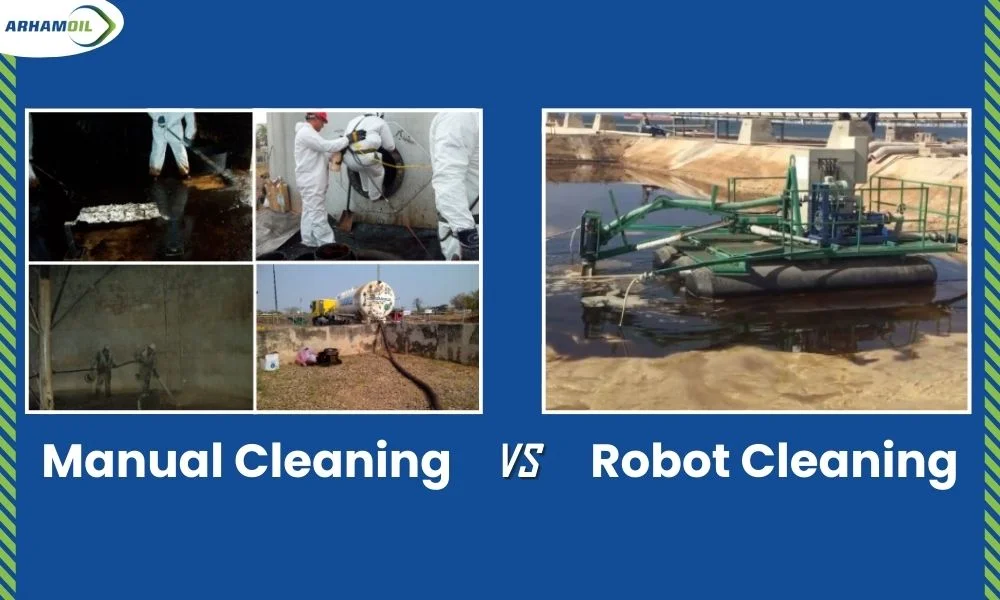How Robotic Tank Cleaning is Done? – A Step-by-Step Guide to Safer, Smarter Results
March 14, 2025What is Robot-as-a-Service (RaaS) for Industrial Cleaning?
March 28, 2025Introduction: The Hidden Expense of Neglecting Lagoon Maintenance
In the oil and gas industry, lagoons are the unsung heroes of crude oil management. These vast basins store and treat everything from oily sludge to chemical runoff, ensuring compliance with environmental regulations. But when it comes to cleaning them, many companies face a critical dilemma: stick with traditional manual methods or embrace robotic innovation?
At Arham Oil, we’ve spent years perfecting lagoon cleaning solutions that prioritize safety, efficiency, and cost-effectiveness. In this blog, we’ll break down the true costs of manual versus robotic lagoon cleaning—and why partnering with us ensures you never overpay for subpar results.
Manual Lagoon Cleaning: The High Price of “Business as Usual”
Manual lagoon cleaning relies on human labor for sludge removal, inspection, and waste disposal. Here’s why it’s costlier than you think:
1. Labor Costs: The Visible Burden
- Large Crews: Manual cleaning requires teams of workers to enter the lagoon, shovel sludge, and operate pumps. Labor costs add up quickly, especially for large or remote sites.
- Overtime & Delays: Unpredictable factors like weather or equipment failures extend project timelines, leading to overtime pay.
2. Downtime: The Silent Profit Killer
- Weeks of Shutdowns: Manual methods often require draining the lagoon and halting operations for weeks. Downtime can mean six-figure daily losses for a facility processing thousands of barrels daily.
- Slow Progress: Human fatigue and manual pumping slow sludge removal, dragging out timelines.
3. Safety Risks: The Liability No One Talks About
- Toxic Exposure: Workers face hazardous fumes, unstable sludge, and pathogens like hydrogen sulfide.
- Accidents & Fines: Confined-space entry accidents can lead to OSHA fines, lawsuits, and reputational damage.
4. Waste Disposal: The Overlooked Expense
- Landfill Fees: Manual methods often lack precision, leading to higher volumes of contaminated waste.
- Environmental Penalties: Improper sludge handling risks EPA fines or community backlash.
Robotic Lagoon Cleaning: Smarter, Faster, and Cost-Effective
Robotic lagoon cleaning uses autonomous machines and AI-driven tools to remove sludge, inspect surfaces, and recycle waste—without human entry. Here’s how it cuts costs:
1. Reduced Labor Dependency
- Smaller Teams: Operators control robots remotely, slashing labor needs by up to 70%.
- No Hazard Pay: Eliminating human entry reduces insurance premiums and worker compensation risks.
2. Minimal Downtime
- 24/7 Operation: Robots work around the clock, unaffected by weather or fatigue. A 3-week manual project can be completed in 10 days.
- Partial Draining: Some robotic systems clean while the lagoon remains partially operational, reducing shutdowns.
3. Precision Waste Management
- Targeted Sludge Removal: Sensors identify and extract sludge layers, reducing waste volume by 30–50%.
- Recycling Revenue: Recovered oil and solids are repurposed into asphalt or biofuels, offsetting costs.
4. Long-Term Savings
- No Repeat Visits: Robotic scrubbing removes 95%+ of sludge, preventing rapid re-accumulation.
- Predictive Maintenance: AI detects corrosion or leaks early, avoiding costly repairs.
Cost Comparison: Manual vs. Robotic Lagoon Cleaning
Let’s compare the two methods for a mid-sized lagoon (1-acre area, 10-foot sludge depth):
| Cost Factor | Manual Cleaning | Robotic Cleaning |
| Labor | $xx (20 workers) | $xx (3 operators) |
| Downtime Losses | $xx (14 days) | $xx (6 days) |
| Waste Disposal | $xx | $xx (reduced volume) |
| Safety/Insurance | $xx (permits, gear) | $xx (remote monitoring) |
| Total | $xx | $xx |
Note: Figures are illustrative. Actual costs vary by project size and location. For Information reach us out, we will provide all the details!
The Bottom Line: Robotic cleaning saves 62% upfront and prevents recurring expenses from inefficiencies.
Why Arham Oil Leads the Robotic Revolution
While others dabble in automation, Arham Oil delivers unmatched value through:
1. Proprietary Technology
- SludgeSeeker™ AI: Our robots map sludge density in real time, optimizing removal paths to save time and fuel.
- EcoVac System: Patented suction tech captures 99% of sludge, minimizing waste and maximizing recycling.
2. Safety Without Compromise
- Zero Human Entry: ATEX-certified robots handle explosive environments, ensuring compliance with OSHA 1910.146.
- 24/7 Monitoring: Live dashboards let you track progress without setting foot onsite.
3. Tailored Solutions
- RaaS Model (Robot-as-a-Service): Pay per project—no upfront investment.
- Hybrid Cleaning: Combine robotic and manual methods for phased lagoon maintenance.
4. Sustainability Commitment
- Closed-Loop Recycling: Partner with us to turn sludge into revenue-generating materials.
- Carbon-Neutral Operations: Solar-powered robots and electric pumps reduce your site’s footprint.
The Hidden Costs of “Cheap” Manual Cleaning
Many contractors advertise low per-hour rates for manual cleaning, but hidden costs lurk beneath:
- Project Delays: Manual crews often underestimate sludge volume, leading to budget overruns.
- Regulatory Gambles: Improper disposal or worker injuries invite fines that erase “savings.”
- Environmental Risks: Incomplete sludge removal leads to faster re-contamination, doubling long-term costs.
With Arham Oil, you get transparent pricing and guaranteed results—no surprises.
To Summarize: Invest in Efficiency, Not Excuses
Lagoon cleaning isn’t just a maintenance task—it’s a strategic decision impacting safety, compliance, and profitability. Manual methods may seem familiar, but their hidden costs and risks are unsustainable in today’s competitive landscape.
At Arham Oil, we’ve redefined lagoon cleaning with robotics that work harder, faster, and smarter. From AI-driven sludge removal to zero-risk operations, we’re the only partner delivering measurable ROI and peace of mind.
Ready to Slash Costs and Risks?
Contact us for a free lagoon assessment and discover how robotic cleaning can transform your bottom line.


